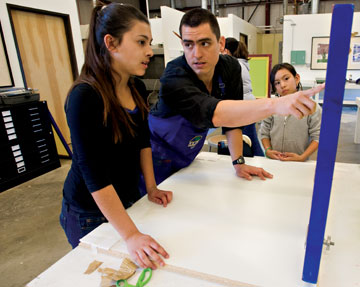Volume 27 · Number 4 · Summer 2010
Drawing on Culture

Carlos Jackson, artist and Chicana/o studies professor, shows Jenifer Suastegui, left, and her sister, Esmeralda Moya, how to correct errors on a silkscreen before they start printing at the TANA community art center in Woodland. (Photo: Karin Higgins/UC Davis)
They come from across the street and across town, one at a time and in small clusters to claim a stool, a little space and some collective inspiration to work on a drawing, a silk screen or an art project of their choice.
Since mid-January, the UC Davis-run TANA youth art center has been open for business often five days a week, including daylong sessions on Saturdays.
“It’s a good place. It will help some kids stay out of trouble,” said 18-year-old Alex Ibarra, unwittingly expressing the essence of the vision that drove a six-year crusade to convert a Yolo County Housing warehouse into a youth art studio.
The center, conceived and operated by the Department of Chicana/o Studies, is a throwback to community art workshops that existed in more urban settings decades ago. TANA stands for Taller Arte del Nuevo Amanecer, or Art Workshop of the New Dawn.
Cultivating community
Renovated with $342,000 in federal grants, the center is across the street from a large, subsidized housing neighborhood and was designed to appeal to teenagers and other youth who live there and throughout the community.
Through silk-screen printing and mural painting, the center will attempt to cultivate the cultural and artistic life of the community, while encouraging participants to seek higher education and self-determination, supporters say.
“Art is like magic. It can lift people from the ashes,” said Malaquias Montoya, the professor emeritus behind the project, when it finally opened in December.
Multimedia
“What this center is about is to bring art and culture — even for a moment — to lighten the load of the people we are trying to reach and, in that moment, they can see a better tomorrow,” Montoya said.
One of the most prominent living Chicano artists, Montoya has used his art before to inspire young people — working with UC Davis students and local youths to paint murals in a number of communities, including Woodland.
An instant asset
Carlos Jackson, an assistant Chicana/o studies professor and director of TANA, says budding artists have been pouring into the center on Saturdays, with smaller groups for the afternoon weekday sessions.
Most bring their own concepts for silk screens, although mural-painting classes are taught twice a week, on Tuesdays and Thursdays.
“Once we opened the doors, they just started coming,” Jackson said. “My main priority is getting a lot of younger kids, kids who live in the neighborhood to feel like this is their place and to give them something to do.”
Sitting nearby, T.J. Gonzales, a 17-year-old Woodland High School junior, was adding finishing touches to a pair of drawings he hopes to reproduce as his first silk screen. Gonzales said he comes to the center every day it is open.
“I want to become an artist just like these guys here,” the teenager said, alluding to Jackson and his UC Davis student assistants.
“I enjoy being here,” Gonzales continued. “When I go home, I draw for three to four hours by myself. When I come here, they have all these tools and work space I can use.”
A few minutes later, when three younger girls arrive together, Jackson gives a quick reminder of the rules.
“There’s no running around. There’s no food,” he says. “People drop stuff and then the mice come.”
In June, the center unveiled the first mural produced at its Chicano Studies workshops. The 8-by-40-foot project portrays images of a nearby cannery, for which it was made.
Opening other doors
In addition to providing a multipurpose gathering place for the larger community, many hope the TANA center will provide university role models for local youth.
“As the daughter of a sharecropper who was the first in his family to go to college, I know first-hand the power of education,” said Jessie Ann Owens, dean of the Division of Humanities, Arts and Cultural Studies.
“Access is crucial and TANA is a terrific way of bringing the university to the community and the community to the university.”
The city of Woodland awarded the funds that financed the remodeling of the 3,600-square-foot maintenance shed, from Woodland’s allocation of federal community development block grants.
In addition to the federal grants, TANA received funding from UC Davis, the California Department of Education, the California Arts Council and the Yolo County Arts Council. The center also is supported by the TANA Community Advisory Group chaired by alum Francisco Rodriguez ’85, M.S. ’97, president of Mira Costa College in Oceanside.
Lisa Baker, executive director of the Yolo County Housing Authority, called the center’s opening one of the year’s highlights for the agency and greater Woodland area. The housing authority provided the building under a $1-a-year lease.
“The center is an opportunity to bring art education to the ‘front door’ of our housing community, while helping to engage older youth and teens,” Baker said.
The center also will serve as an extension of the university where other UC events open to the community can be held.
Woodland Mayor Skip Davies said the project provided “a great opportunity for the city to strengthen our partnerships with UC Davis and Yolo County Housing” that benefit Woodland youth. “The opportunity to create and study art will be a lifelong asset for those who choose to participate.”
